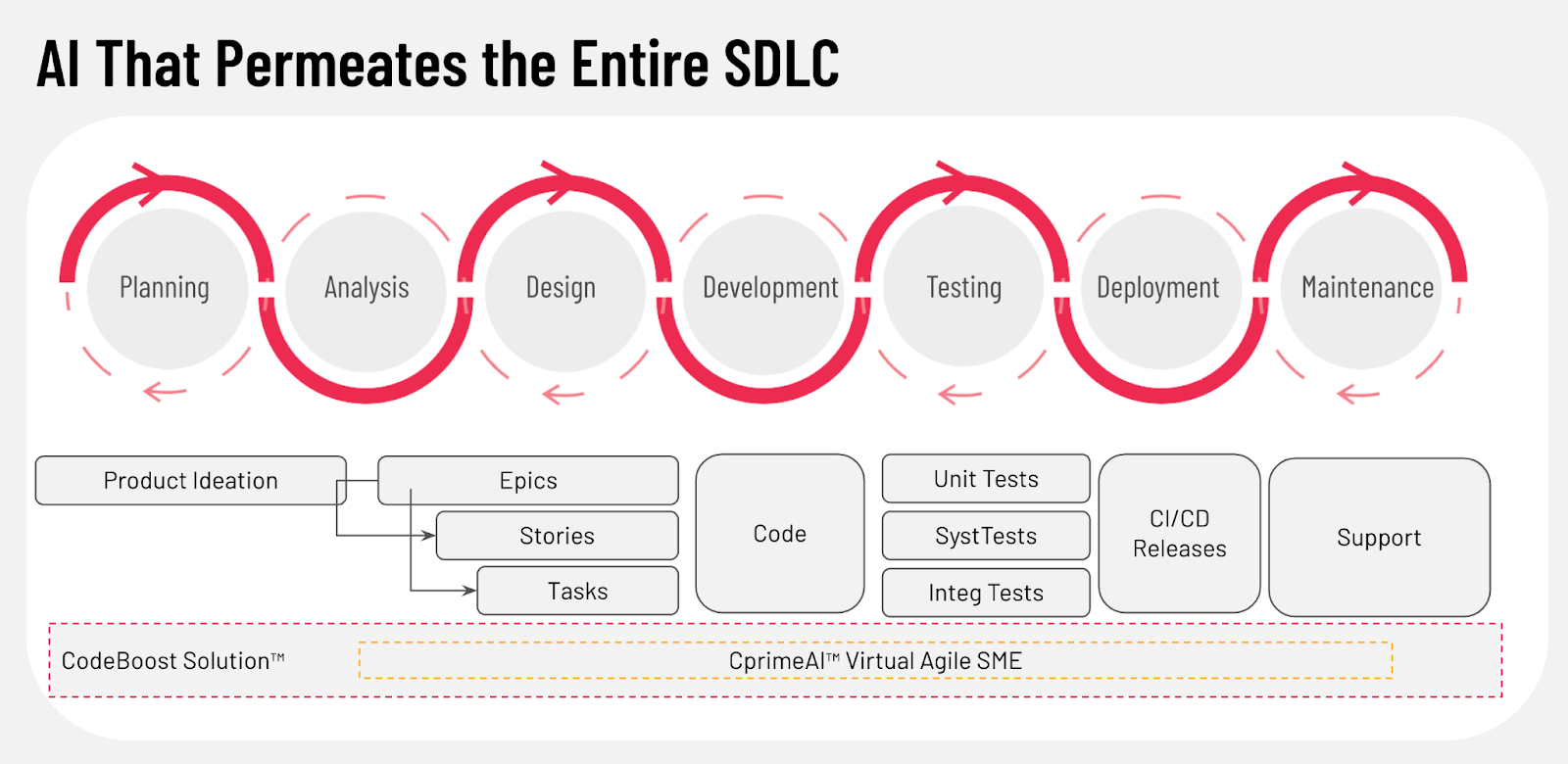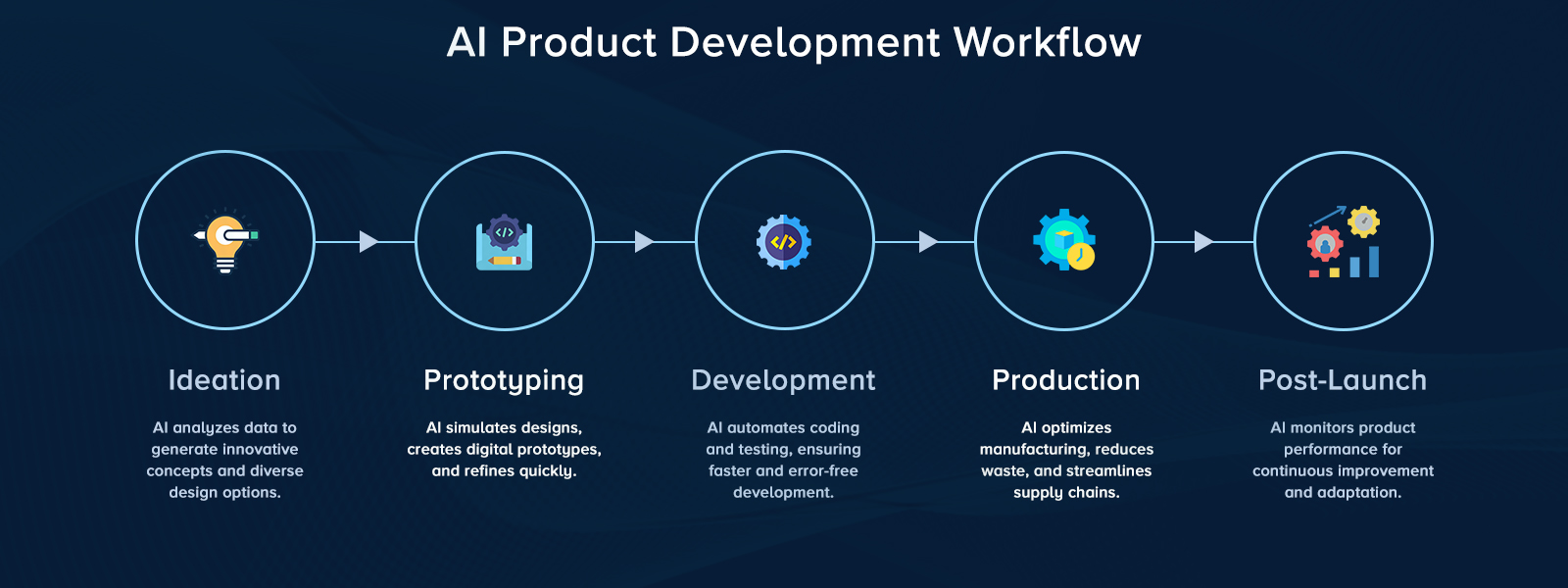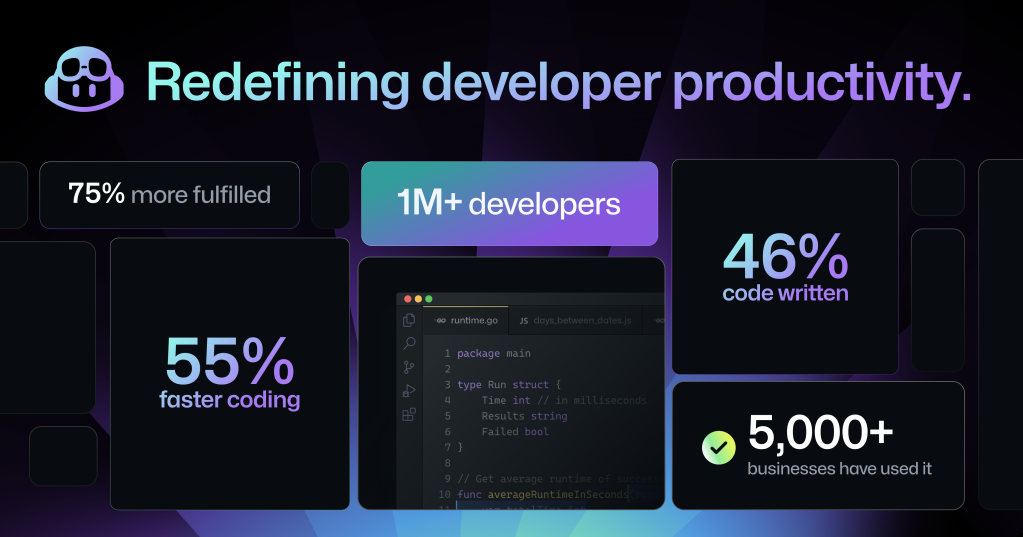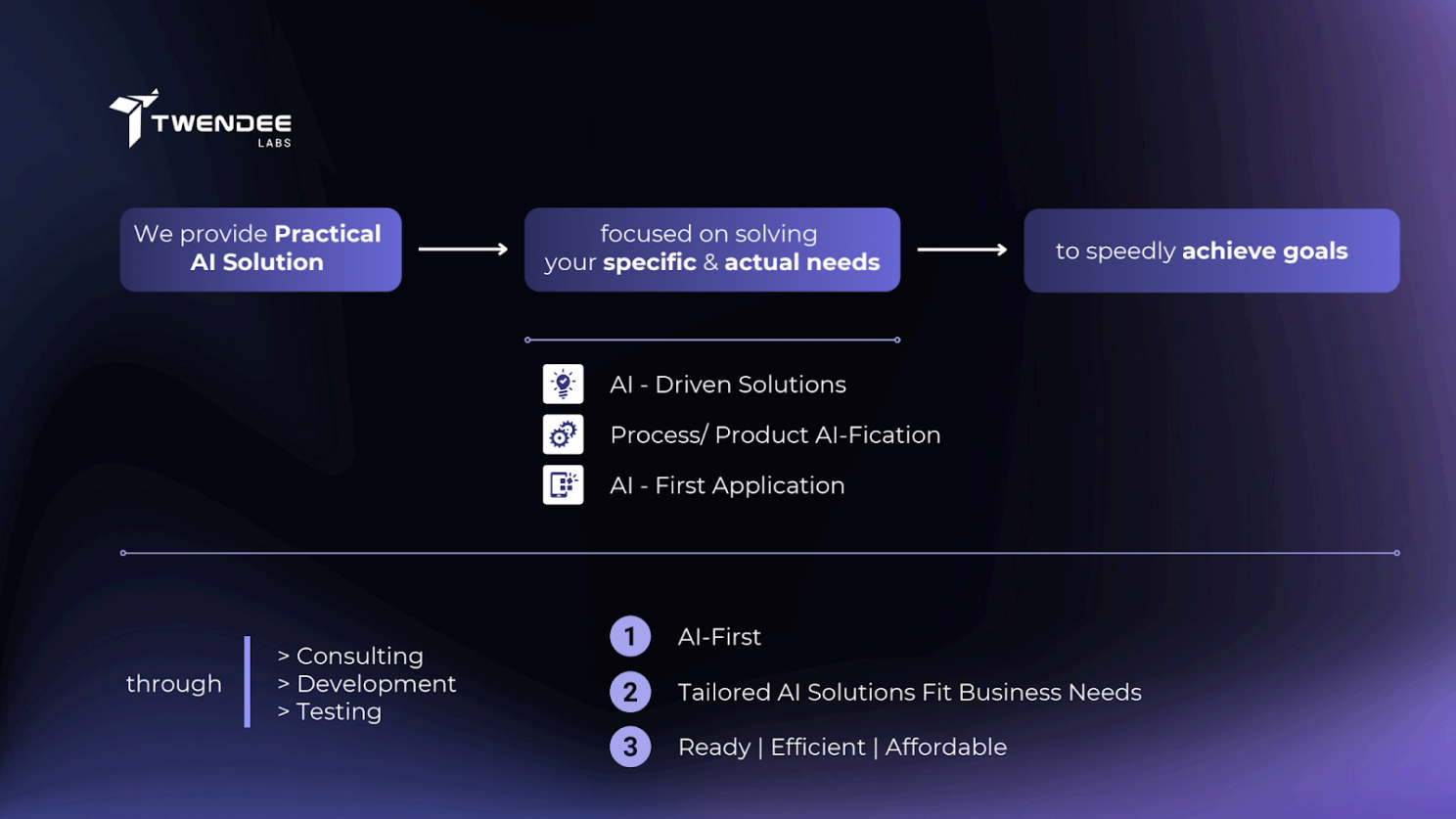Artificial intelligence has moved from assisting developers to redefining how software itself is built. AI-first development marks this shift, where AI becomes the foundation of design, coding, and testing rather than a supporting feature.
As apps evolve into learning systems that adapt in real time, enterprises face a pressing challenge: integrating AI across the software lifecycle without disrupting existing architectures. Balancing innovation with reliability has become the core question driving the future of modern development.
How AI-First Development Redefines the Software Lifecycle
In an AI-first model, software no longer moves through fixed phases. Intelligence is embedded into every stage from planning to production creating systems that evolve as they operate.

AI integration transforms the software lifecycle into an adaptive, data-driven system (Source: Cprime)
Ideation Becomes Predictive
In an AI-first development environment, ideation no longer relies solely on human creativity or intuition. Predictive models now analyze large datasets from user behavior to historical sprint data to uncover patterns and opportunities invisible to traditional methods. Ideation becomes a process of learning from signals, not guessing trends.
Key shifts include:
Data-driven discovery: AI identifies gaps in customer journeys, emerging feature demand, and product-market misalignments before they surface as revenue losses.
Faster validation cycles: Generative models translate raw feedback into structured requirements, reducing the time from idea to approved feature.
Continuous adaptation: AI tools monitor adoption metrics and feed insights back into the backlog, keeping roadmaps aligned with evolving market behavior.

AI-first development turns product creation into an adaptive, insight-driven system (Source: Matellio)
AI now enhances the full spectrum of product creation: ideation becomes predictive, prototyping becomes simulated and iterative, and post-launch turns into an ongoing optimization engine. This intelligent rhythm sets the foundation for AI-assisted coding and automated testing in the next phase of development.
Coding Becomes Collaborative
AI-assisted coding has transformed development from a solo effort into a true collaboration between human expertise and machine intelligence. Instead of writing every line, developers now orchestrate the coding process, guiding AI models that understand context, patterns, and intent. GitHub’s research shows that developers using Copilot complete tasks 55% faster and report higher satisfaction as AI takes over repetitive syntax and boilerplate generation.
Yet the deeper shift isn’t just in speed, it’s in how collaboration happens. AI copilots have evolved into active development partners, capable of recognizing business logic, suggesting improvements, and preventing code conflicts before they occur. What once required senior review now unfolds in real time within IDEs.
Key transformations shaping this new collaboration model include:
Contextual intelligence: AI engines analyze entire repositories to suggest code that aligns with existing architecture and dependencies.
Continuous feedback loops: Each developer interaction helps retrain the model, improving accuracy and adaptability across projects.
Shared learning: AI levels up team performance by surfacing best practices and teaching patterns through real-time examples

AI-assisted coding improves developer collaboration and productivity, with Copilot driving faster coding and higher satisfaction (Source: GitHub)
These shifts are redefining the developer experience. With AI now contributing to up to 46% of code and helping teams feel 75% more fulfilled, collaboration becomes an evolving cycle of co-creation. Developers focus less on mechanics and more on architecture, debugging, and innovation turning coding into a strategic layer of the AI-first software lifecycle.
Testing Becomes Continuous
In an AI-first development environment, testing no longer happens after coding, it runs alongside every stage. Integrated into DevOps pipelines, AI transforms quality assurance into a living feedback system rather than a post-release task.
AI testing tools now generate, execute, and refine test cases automatically. Trained on historical data, they predict failures before deployment. Gartner projects that by 2026, 40% of large enterprises will use AI-augmented testing to accelerate release cycles and improve coverage.
Key advances show how AI reshapes testing logic:
Predictive coverage: AI finds untested pathways and closes gaps automatically.
Self-healing tests: When app interfaces change, AI adjusts affected scripts in real time.
Anomaly detection: Machine learning monitors logs continuously, flagging subtle regressions.
Testing has become a predictive, adaptive discipline each build feeding intelligence into the next. Quality now improves through learning, not inspection.
Yet automation brings new security and compliance risks. When AI writes code or tests, accountability and validation must follow. As noted in this analysis on AI-generated code and compliance guardrails, enterprises need frameworks that vet machine output as rigorously as human code.
Rather than simply running tests faster, the challenge is managing data and oversight at scale. Twendee helps embed AI-driven testing frameworks into CI/CD pipelines, ensuring automation enhances, not undermines, enterprise security and compliance.
Applications Become Living Systems
The outcome of this evolution is profound: applications are no longer static builds that age between releases, they become adaptive, self-improving systems. In AI-first development, software continues to evolve after deployment through continuous learning loops that draw on production data, user behavior, and system telemetry.
Modern applications now embed feedback mechanisms that detect inefficiencies, predict usage shifts, and autonomously optimize performance. A 2025 McKinsey study found that enterprises adopting post-deployment AI analytics reduced maintenance costs by up to 30% and improved system uptime by 40%, as updates became proactive rather than reactive.
These adaptive systems represent a shift from maintenance to evolution:
Data-to-decision pipelines: Live data trains internal AI agents to fine-tune features and anticipate user needs.
Autonomous optimization: AI adjusts parameters in real time to balance performance, cost, and energy consumption.
Closed-loop governance: Continuous learning occurs under strict compliance and policy control, ensuring that automation enhances rather than compromises oversight.

Twendee’s AI-first solution framework integrates consulting, development, and testing to deliver tailored, adaptive AI applications aligned with real business goals (Source: Twendee Labs).
This is where the meaning of AI-first truly emerges, not in faster builds but in systems that improve themselves. For enterprises, this means creating digital ecosystems capable of learning, adapting, and aligning with business priorities over time.
This philosophy is already materializing in frameworks like Twendee’s, which emphasizes practical AI integration tailored to real business needs. By combining consulting, development, and testing in a continuous feedback cycle, Twendee helps organizations transition from maintaining software to cultivating living, evolving applications.
Integrating AI Without Breaking the Architecture
For most enterprises, moving to AI-first development isn’t just a technology upgrade, it’s an architectural shift. Existing systems were built for deterministic logic, not for models that learn, adapt, and evolve. The challenge lies in embedding AI intelligence without destabilizing what already works.
To achieve this, leading organizations follow three key integration principles:
1. Start Small, Then Scale
Enterprises begin by introducing AI through pilot projects targeting isolated workflows for instance, automating code review or predictive QA analysis. Successful pilots then expand into full pipelines. This gradual adoption minimizes disruption and allows for controlled learning curves across teams.
2. Use Middleware and APIs for Seamless Connectivity
Rather than rewriting legacy systems, companies deploy AI-ready middleware and API connectors to bridge traditional applications with new AI services. This “overlay” model lets AI interact with existing data flows and decision logic without deep refactoring, preserving system stability while extending intelligence capabilities.
3. Build a Human-AI Operating Model
AI doesn’t replace developerdevelopers, it reshapes their workflow. The most successful teams establish clear collaboration protocols between human judgment and machine prediction. Humans oversee strategic choices, while AI agents manage code generation, testing, and monitoring. This dual-control model ensures agility without sacrificing accountability.
When implemented effectively, this approach creates a phased evolution instead of a sudden transformation systems get smarter without breaking. Twendee applies this principle by integrating AI tools directly into DevOps pipelines, enabling enterprises to automate safely, maintain architectural integrity, and accelerate delivery cycles without re-engineering their entire stack.
Conclusion
AI-first development isn’t just a faster way to build software but a new way to think about it. Codebases evolve through learning loops, quality assurance becomes predictive, and applications continue improving long after deployment. The boundary between development and operation blurs into a single intelligent system.
For enterprises, success in this new era depends on how seamlessly AI integrates with existing architectures. It’s not about replacing legacy systems but extending them, turning static products into adaptive, data-driven ecosystems.
Organizations that achieve this balance will move beyond automation to continuous innovation, where every release learns from the last!
Discover how Twendee helps enterprises implement AI-first software development through automation-driven DevOps pipelines and stay connected via Facebook, X, and LinkedIn.
